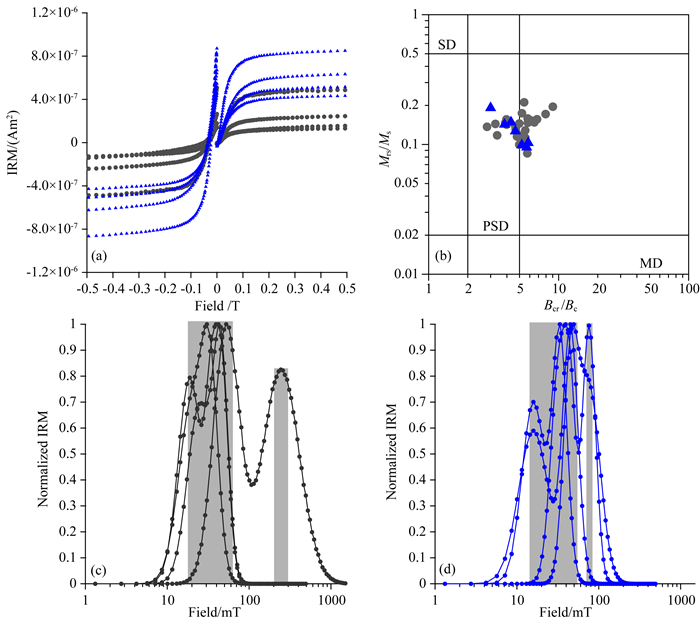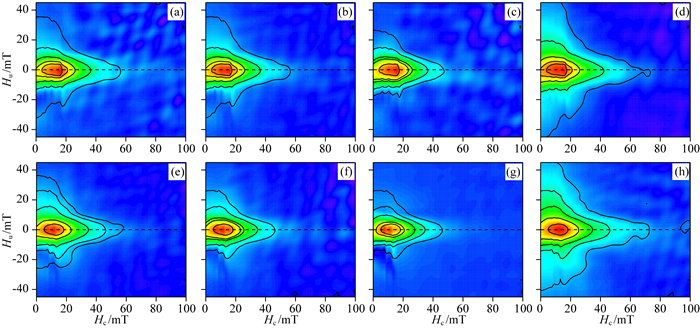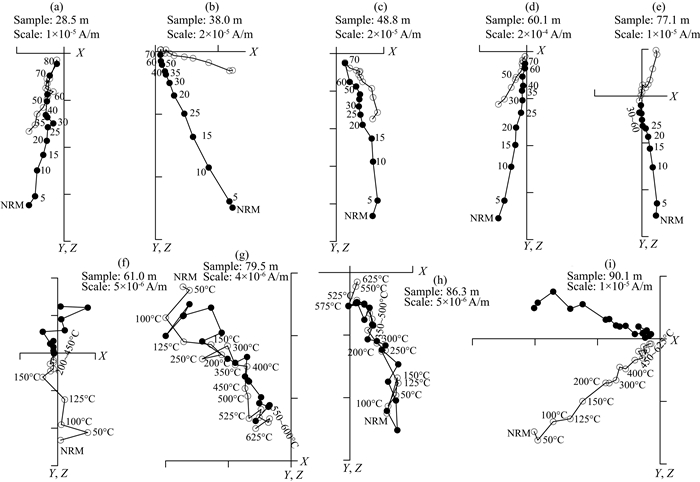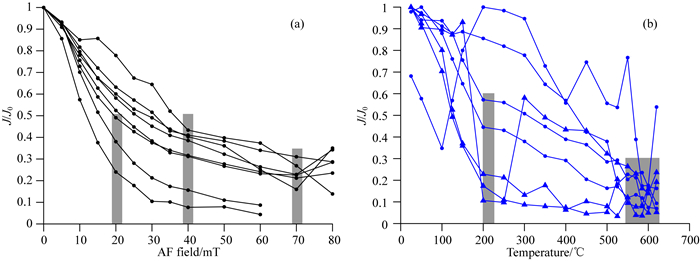2. 国家海洋局第一海洋研究所海洋沉积与环境地质重点实验室, 青岛 266061;
3. 中国科学院三亚深海科学与工程研究所, 三亚 572000;
4. 国家深海基地管理中心, 青岛 266061;
5. 国家海洋局第二海洋研究所工程海洋学重点实验室, 杭州 310012
2. Key Laboratory of Marine Sedimentology and Environmental Geology, First Institute of Oceanography, State Oceanic Administration, Qingdao 266061, China;
3. Sanya Institute of Deep-sea Science and Engineering, Chinese Academy of Sciences, Sanya 572000, China;
4. National Deep Sea Center, Qingdao 266061, China;
5. Key Laboratory of Engineering Oceanography, Second Institute of Oceanography, State Oceanic Administration, Hangzhou 310012, China
The Bohai Sea is part of the epicontinental seas in eastern China, and the Bohai Basin is one of the Cenozoic extensional basins in this area. In this study, we have carried out detailed rock magnetic investigations on the sediments from the Lz908 borehole sedimentary sequence of the southern Bohai Sea and the modern fluvial/marine sediments from the adjacent areas. The Lz908 core was drilled to a depth of 101.3 m below the surface. The upper 54.3 m of the core contains dominantly marine and coastal silts, sandy silts and fine-grained sands, and the lower 47.0 m consists mainly of lacustrine and fluvial silts. The rock magnetic measurements include temperature-dependent magnetic susceptibility (-T curves), hysteresis loops and associated ΔM and dΔM/dB curves, isothermal remanent magnetization (IRM) acquisition curves and backfield curves of IRM, first order reversal curve (FORC) diagrams, and stepwise thermal and alternating field demagnetization.
The multiparameter rock magnetic measurements indicate that the sediments consist of a mixture of different magnetic minerals with variable grain size or concentration. The behaviors of -T curves suggest the presence of magnetite and maghemite in the sediments and the dominant contribution to susceptibility by magnetite. The combination of hysteresis loops and associated ΔM and dΔM/dB curves, IRM acquisition curves and backfield curves of IRM, and stepwise demagnetization suggest the dominance of low-coercivity magnetic minerals, such as magnetite and/or maghemite. High-coercivity magnetic minerals, e.g., hematite and/or goethite are also present, but do not dominate the magnetic signals. The Day plot and FORC diagrams indicate that the dominant ferrimagnetic mineral (magnetite) is of relatively coarse-grained nature, that is, large pseudo-single domain to multidomain-like. Magnetite is the dominant carrier of the characteristic remanent magnetizations (ChRMs). There is no remarkable difference about rock magnetic properties between modern fluvial/marine and borehole sediments, suggesting negligible post-depositional reworking.
晚新生代以来,伴随着太平洋板块向亚欧板块俯冲,在亚洲大陆东部形成了一系列边缘海(Wang,2005).与此同时,亚洲大陆与太平洋之间的物质与能量交换过程也发生了深刻变革(Wang,1999).因此,与这些边缘海及其周边陆表海演化相关地质过程一直是学术界关注的热点(如Tamaki and Honza,1991; Jolivet et al.,1994; Wang,1999,2005).
渤海是我国东部一个三面被陆地环绕的陆表海,仅以狭窄的海峡与黄海相通(中国科学院海洋研究所,1985).由于海陆相互作用强烈,渤海地区对气候、环境演变及海平面变化十分敏感.构造上,渤海从新生代开始到渐新世末期一直以伸展断陷为主,形成一系列隆起和坳陷相间的构造单元(Allen et al.,1997).从新近纪开始,渤海进入坳陷阶段,呈现整体沉降(Allen et al.,1997; Hu et al.,2001; He and Wang,2003),堆积了厚达2000~3000 m的湖相、河流相、海相等多种类型的沉积地层,为研究东亚季风历史、亚洲内陆干旱化的海洋角色、海陆交互影响等重要问题提供了丰富的地质材料(中国科学院海洋研究所,1985; 刘东生,2009).自20世纪60年代以来,渤海地区布设了数以千计的勘探钻孔,为揭示区域地质构造、水文过程、资源状况提供了宝贵依据.例如,赵松龄等(1978)根据71个沿海平原钻孔的层序地层学研究,确立了晚第四纪以来中国东部三次海侵的基本框架.中国科学院海洋研究所(1985)采用古地磁、微体古生物、植物孢粉、沉积物粒度等多指标分析方法,系统研究了位于渤海中央海盆的BC-1孔,确定了渤海中部过去十五万年以来经历了六次海侵事件,并且其周期与太阳辐射的岁差基本一致.Wang等(1986)和Zhao(1986)基于近百口钻井资料,分别给出了三次主要海侵事件的可能影响范围,并提出第二次海侵事件的影响范围是三次事件中最大的.20世纪90年代以来,发表的成果显著增多,如BQ1孔(阎玉忠等,2006)、寿光E孔(赵松龄,1996; 韩德亮,2001)、S3孔(庄振业等,1999)、A1和A5孔(张祖陆等,2005)、G3和DY孔(Yang et al.,2006)、HB-1孔(Liu et al.,2009)、BZ1-BZ2-TN3孔(姚政权等,2006; 陈宇坤等,2008; 肖国桥等,2008)等等.王强和田国强(1999)在总结这些海侵研究成果的基础上,讨论了新构造运动的可能影响.王宏等(2004)、王宏和范昌福(2005)对渤海地区的全新世地层中的14C测年进行了统计,给出了各地区碳库效应的大小及其校正系数.
由于长序列的样品不易获取,相关研究主要集中在华北的滨海平原区和现代黄河三角洲地区.虽然经过磁性地层学研究的钻孔已有40余个,但不同地点、不同构造单元钻孔的磁性地层年代结果存在较大差异(如,施林峰等,2009;刘东生,2009).根据这些磁性地层学结果推断的第四纪期间所发生的重要环境事件,虽然偶能粗略对比(刘东生,2009),但有时年代差异较大,难以统一.造成这种情况的重要原因之一是,由于客观条件的限制,早期的古地磁工作常常缺乏详细的岩石磁学研究基础,尤其对于物质来源和沉积动力均非常复杂的海陆交互相沉积物,对载磁矿物及其记录剩磁特征的准确厘定对评价古地磁结果的可靠性至关重要.
此外,对从渤海沉积物中获得的环境变化序列也存在截然不同的解释.例如,赵松龄(1996)认为渤海海陆交互相沉积物的磁化率与黄土磁化率类似,可以反映区域的干湿状况.但Yi等(2012)则更倾向于认为渤海海陆交互相沉积物的磁化率变化反映的是物源区的剥蚀过程.对环境替代指标序列的环境意义的不同解释,反映了对沉积物剥蚀、运移和沉积过程的认识不足.因此,本文利用渤海南部海域莱州湾获得的一支沉积柱状样品进行详细的岩石磁学研究,并与钻孔附近海域的现代沉积物进行对比,以获得陆源碎屑物质在沉积过程中可能发生的变化,进而评估古地磁数据的可靠性与环境变化序列的意义.
2 地质背景与研究材料研究区位于郯庐断裂中段沂沭断裂的东西两支之间(高维明等,1980; Zhang et al.,2003),在中新世中晚期以后,整体基本处于稳定的沉降环境(Allen et al.,1997; Hu et al.,2001; He and Wang,2003),表现为地震剖面上不整合面以上同相轴基本平行、连续稳定,地层无较大的起伏,也无较大的不整合面产生(吴时国等,2006;Yu et al.,2008).
晚第四纪以来,沉积环境之间的转化主要集中于三角洲—河口—潮坪三种环境(薛春汀和丁东,2008),当海水大范围退去后,海陆交互相沉积有可能为河流冲积扇的前缘所替代(孟庆海等,1999),或者成为洪积扇(陈明等,1991)、海岸沙丘(陈明等,1991; 赵松龄,1996; 于洪军等,1999)的一部分.在此之前,研究区的沉积环境主要为河湖相(中国科学院海洋研究所,1985).
Lz908孔的GPS坐标为37°09′N、118°58′E,海拔约6 m,于2007年钻进取芯.全孔取芯率为75%,实际进尺101.3 m.20世纪中期之前,钻井区为海水覆盖.钻孔上部54.3 m为晚第四纪海侵沉积,下部47 m是河湖相沉积(Yi et al.,2015).本次研究从不同沉积相类型中(包括海相、河流相和湖相)选择样品共31份,连同钻孔附近海域的小清河及其河口外现代表层沉积物样品7份(杜廷芹等,2008; 陈斌等,2009),一起进行多参数的岩石磁学研究(38份样品的详细信息见表 1),详细解析Lz908孔沉积物及现代小清河表层沉积物中磁性矿物的组成、粒度特征以及剩磁载体的类型,为下一步开展磁性地层学与环境磁学研究提供坚实的岩石磁学基础.
| | 表 1 本文测试样品的信息 Table 1 Numbers, sampling location (depths or GPS), and sedimentary environments and lithology of the measured samples in this study |
磁化率随温度的变化特征(χ-T曲线)也可以用来揭示磁性矿物的种类(邓成龙等,2000; Deng et al.,2001)和粒度特征(Deng et al.,2006).χ-T曲线利用卡帕桥KLY-3型(Agico Ltd.,Brno)进行测试.对每个样品以12 ℃/min的速率在氩气环境下加热至700 ℃,然后再降至室温(图 2).
 | 图 1 区域地形地貌略图及Lz908孔的位置(a)及现代表层沉积物样品的采样位置(b) Fig. 1 (a) Geographical settings and location of the south Bohai Sea in eastern China and the Lz908 borehole (solid triangles); (b) Locations of the samples of modern fluvial/marine sediments (dots) |
 | 图 2 磁化率随温度变化曲线. (a—d) 钻孔沉积物(对应深度为a,28.7 m:b,60.4 m;c,90.4 m;d, 92.0 m;下同); (e—h) 现代小清河表层沉积物(对应站位为:e,A2:f,E2;g,H1;h,H8;下同) 箭头指示加热(粗)与冷却(细)过程. Fig. 2 High-temperature magnetic susceptibility measurements (χ-T curves) of samples from the Lz908 borehole (a—d) and modern sediments (e—h) Arrows represent heating (bold) and cooling (thin) runs. |
所有样品的升温曲线都在580 ℃(即磁铁矿的居里温度)左右出现明显转折,说明所测样品的磁化率主要是由磁铁矿贡献的.部分样品的升温曲线在280 ℃左右呈现微弱的峰值,并且在280~330 ℃磁化率逐渐下降(图 2g),这是由于高磁化率、热不稳定的磁赤铁矿受热分解转化成低磁化率、热稳定的赤铁矿造成的(Deng et al.,2001,2004).部分样品的升温曲线在520 ℃左右(图 2a,2e—2g)出现显著的峰值,这通常是由于加热过程中热不稳定的含铁硅酸盐和黏土矿物受热分解新生成磁铁矿所致(Deng et al.,2004).
所有样品的降温曲线都位于升温曲线之上,并且也都在580 ℃左右出现明显转折,如果以升温、降温曲线上室温磁化率为基准,热处理后磁化率增强了3~20倍不等,说明在热处理过程中生成了大量的磁铁矿.此外,图 2c所示的样品,其降温曲线在580 ℃至室温之间基本保持水平,磁化率变化不大,说明新生成的磁铁矿粒度较粗,可能为较大的准单畴至多畴磁铁矿颗粒(Deng et al.,2006).
3.2 磁滞回线磁滞行为强烈受控于磁性矿物的类型和粒度,因此,可用磁滞回线来确定岩石中磁性矿物的组成(Tauxe et al.,1996).磁滞回线的测试利用振动样品磁力仪(MicroMag 3900 VSM)完成,最大外加磁场为±1.5 T.
钻孔与现代沉积物样品的磁滞回线均表现出相似的特征.大部分样品的磁滞回线均在0.3~0.5 T闭合(图 3a—3h),说明沉积物中以低矫顽力的磁性组分为主.少量样品表现为微弱的“鹅颈”状特征(图 2c),说明样品中不仅含有低矫顽力磁性矿物,还含有高矫顽力磁性矿物.
 | 图 3 磁滞回线(a—d,钻孔样品;e—h,现代沉积物),ΔM曲线(i,灰色粗线为钻孔样品,蓝色细线为现代沉积物样品) 和dΔM/dB曲线(j,钻孔样品;k,现代沉积物样品) 测磁滞回线的最大外加场为±1.5 T,dΔM/dB曲线的数据截至0.5 T. Fig. 3 Hysteresis loops (a—h) along with the ΔM (i) and dΔM/dB (j,k) curves. (a—d) Borehole samples; (e—h) Modern sediment samples. Grey bold lines and blue thin lines in (i) represent ΔM curves for borehole samples and modern sediment samples, respectively. dΔM/dB curves for borehole samples and modern sediment samples are shown in (j) and (k), respectively Note that the hysteresis loops were measured in fields up to ±1.5 T, and that the dΔM/dB curves are cut off at 0.5 T for reasons of clarity. |
由磁滞回线推导出来的ΔM和dΔM/dB曲线可以用来区分不同磁组分的矫顽力谱,仅反映剩磁载体的信息,不能反映超顺磁组分,因此可以用来区分这两种因素导致的磁滞回线变形特征(Tauxe et al.,1996; He et al.,2012).钻孔样品的dΔM/dB曲线(图 3j)表现为三峰特征,三个峰值分布位于30~60 mT,90~110 mT和200~300 mT.现代沉积物样品的dΔM/dB曲线(图 3k)也表现为三峰特征,但峰值略有差别,分别位于30~60 mT,120~140 mT和~300 mT.
3.3等温剩磁获得曲线和矫顽力谱分析等温剩磁(IRM)获得曲线与饱和等温剩磁(SIRM)的反向场退磁曲线能够提供矫顽力的信息(Deng et al.,2005; 任收麦等,2015),这有助于识别沉积物中磁性矿物的成分.使用振动样品磁力仪(MicroMag 3900 VSM)测量样品的IRM获得曲线(最大外加磁场为1.5 T)及SIRM的反向场退磁曲线(图 4a).
 | 图 4 IRM获得曲线及其反向场退磁曲线(a),Day氏图(b,灰点为钻孔样品,蓝色三角形为现代沉积物样品)和矫顽力谱分析(c为钻孔样品,d为现代沉积物样品) Fig. 4 IRM acquisition curves and DC field demagnetization curves of the SIRM; (b) Day plots (Grey dots, borehole samples; blue triangles, modern sediment samples); (c) & (d) Coercivity distributions for borehole and modern sediment samples, which are calculated using the Matlab@ 7.1 program |
对于钻孔样品,不同沉积环境样品的IRM获得曲线及其反向场退磁曲线并无本质差异,而IRM0.3T/SIRM 较大的变化范围(0.63~0.95)说明了含有两种以上的矫顽力成分.有些样品具有较高的IRM0.3T/SIRM说明沉积物中主要的磁性矿物为低矫顽力组分或者顺磁性矿物.而个别样品的IRM0.3T/SIRM值很低,指示了高矫顽力矿物的存在.对于现代样品,IRM获得曲线的变化特征与钻孔样品十分接近.
Day氏图(Dunlop,2002)Lz908孔沉积物和现代小清河沉积物中磁铁矿的平均粒度较粗,为较大的准单畴(PSD)至多畴(MD)(图 4b),这与-T曲线揭示出的部分样品中含有较粗颗粒磁铁矿的特征一致(图 2).
通常来说,沉积物中的磁性矿物是多种成分的组合.研究者因此利用数学方法将具有不同矫顽力特征的矿物组分区分开来(如,Egli,2003).这里,我们利用Matlab 7.1对IRM获得曲线进行矫顽力分解(图 4c,4d).这种方法可以有效揭示沉积物中不同矫顽力的磁性矿物组分(如,He et al.,2012; Li et al.,2013).
对于钻孔样品,主要有两种情况(图 4c):(1)仅有一个低矫顽力分量,其峰值位于20~60 mT,代表磁铁矿的信号;(2)另一种是具有两个分量,其中高矫顽力分量的峰值位于200~300 mT,代表赤铁矿的信号.而现代沉积物样品的矫顽力谱特征显示,样品中磁性矿物以低矫顽力组分为主,峰值低于100 mT,但显示多个峰值(图 4d).这一结果与dΔM/dB曲线的结果(图 3j,3k)基本一致,反映了沉积物中主要含有低矫顽力的磁性矿物,同时还有少量高矫顽力的组分.
3.4 一阶反转曲线(FORC)FORC不但可以用来确定磁性矿物矫顽力的分布以及磁性矿物颗粒之间磁相互作用的强弱,而且还可以帮助区分磁性矿物的种类和磁畴状态(秦华锋等,2008; Liu et al.,2015).典型样品的FORC曲线利用振动样品磁力仪(MicroMag 3900 VSM)测量.最大外加场强为1.5 T,测量步长为3.2 mT,每条FORC由125条子曲线组成.测量原始数据由FORCinel version 1.17软件(Harrison and Feinberg,2008)生成FORC图(图 5).结果显示,钻孔样品与现代沉积物样品的表现类似,矫顽力分布在10~30 mT之间,峰值位于15 mT左右;所有样品的FORC等值线均在纵轴上有所展布,说明样品中存在明显的静磁相互作用;等值线椭圆与纵轴相交.综合上述信息,所测样品中的磁性矿物主要是PSD颗粒的(钛)磁铁矿或(钛)磁赤铁矿.部分样品(如图 5d,5h)中可能含有MD颗粒.
 | 图 5 一阶反转曲线. (a—d) 钻孔样品. (e—h) 现代沉积物样品 Fig. 5 FORC diagrams for samples from the Lz908 borehole (a—d) and modern sediments (e—h) |
我们对其中6个钻孔样品进行系统交变退磁,退磁步骤为0(天然剩磁)、5、10、15、20、25、30、35、40、50、60、70、80 mT共13步;再对12个钻孔样品进行系统热退磁,退磁步骤为室温(天然剩磁)、50、75、100、125、150、200、250、300、350、400、450、500、525、550、575、600、625 ℃共18步.退磁正交投影图(Zijderveld,1967)见图 6.样品的剩磁衰减情况见图 7.
 | 图 6 系统退磁结果正交投影图.(a—e)为交变退磁,图中数字单位为mT. (f—i)为热退磁 实心圆代表水平投影,空心圆代表垂直投影. Fig. 6 Orthogonal projections of progressive alternating field (a—e) and thermal (f—i) demagnetization. The numbers in (a—e) refer to the alternating fields in mT The solid (open) circles represent the horizontal (vertical) planes. NRM is the natural remanent magnetization. Note that the magnetic declinations are arbitrary. |
 | 图 7 交变退磁(a)与热退磁(b)过程中剩磁的变化情况 Fig. 7 Remanence decay curves for AF demagnetized (a) and thermally demagnetized (b) samples |
图 6a—6e为其中5个样品的交变退磁结果,均直接趋向原点.在20~30 mT之前,剩磁强度降低较快(图 7a),这代表低矫顽力磁性矿物(主要是磁铁矿)的信号.到70~80 mT时,样品的剩磁强度衰减至天然剩磁的5%~40%,说明高矫顽力磁性矿物(主要是赤铁矿)也是重要的剩磁载体.对这些交变退磁的样品,在30~80 mT之间可分离出线性较好的特征剩磁分量.
热退磁的结果总体上不太理想,图 6f—6i为其中4个样品的热退磁结果,只有图 6i所示的样品退磁效果较好,在300 ℃以后可分离出线性较好的特征剩磁分量.部分样品在200 ℃时剩磁强度已降低到天然剩磁的25%以下(图 7b).对比上述交变退磁与热退磁的结果,对于Lz908孔的沉积物的古地磁学研究,交变退磁方法可能比热退磁方法更为有效;而热退磁效果不好的主要原因,可能是由于沉积物剩磁较弱,加热过程中存在一定的噪声,使得退磁曲线无法稳定趋于原点,或者低解阻温度磁性矿物(如针铁矿)携带的剩磁比例较高,200 ℃以后,可用于计算特征剩磁的点较少所致.
4 讨论通过上述多参数的岩石磁学研究表明,渤海南部莱州湾Lz908孔沉积物及其附近小清河的现代河流沉积物中的磁性矿物主要是磁铁矿,还有少量磁赤铁矿,部分沉积物还含有赤铁矿或者针铁矿.磁铁矿的粒度较粗,为较大的准单畴至多畴颗粒.这些磁性矿物都对样品的天然剩磁有贡献,但特征剩磁的载体主要是磁铁矿.
区域地质资料研究表明,渤海南部的沉积物主要是由小清河、弥河、潍河等区域性河流输入(薛春汀和丁东,2008).我们的岩石磁学研究表明,钻孔样品与现代沉积物样品的磁性矿物成分、粒度等没有显著差异,并且这些样品含的磁性矿物成分也与物源区的岩石中磁性矿物组成较为吻合,因此推断渤海南部的这些沉积物由鲁中山区搬运与堆积至此的过程及沉积后期改造并未显著改变其磁性特征.
磁化率是反映物质被磁化难易程度的一个度量,已被广泛应用于黄土-古土壤序列的研究中,并被认为是有效反映气候变化特征、旋回的环境代用指标(如,Heller and Liu,1986; 刘青松和邓成龙,2009; Deng et al.,2005).在海洋沉积物的研究中,磁化率的变化也被认为在一定程度上能够反映陆源物质的输入、区域风化特征和后期沉积改造等过程,进而与沉积物的粒度变化特征一起用于反演区域环境气候的历史(Yim et al.,2004; Ghilardi et al.,2008; Larrasoaña et al.,2008).海陆交互相沉积物的磁化率主要有四个控制因素(Nádor et al.,2003):(1)区域的风化作用(机械风化与化学风化),这一因素直接影响了磁性矿物的数量、类型、颗粒大小;(2)不同物质源区的混合作用;(3)动力搬运条件,如水动力、风力等,是否具备搬运大颗粒磁性矿物至沉积区的能力;(4)沉积分异作用.
渤海南部的沉积物来源于鲁中山区,其搬运动力为具有高纵比降的区域性河流.这些河流的纵比降在山区内为8~15 m·km-1,在沿海平原变为0.1~0.5 m·km-1.较高的纵比降值说明河流的搬运动力非常强,在大多数时候能搬运较粗的砂粒级的物质至沿海平原(Yi et al.,2012; 李琰等,2014).此外,渤海南部的沉积物主要属于化学风化脱钙脱钠的初级阶段(易亮,2010),指示源区的风化强度相对较弱,控制碎屑物质对河流供应的主导因素可能是机械剥蚀过程.因此,我们认为机械剥蚀作用可能是影响渤海南部沉积物磁化率变化的主导过程.
由于渤海南部沉积物中的主要磁学矿物是颗粒较粗的磁铁矿,我们推测:当鲁中山区剥蚀作用加强时,碎屑物质的增多同时丰富了沉积物中磁性矿物的数量,因此研究区沉积物的磁化率增大;而在机械剥蚀作用减弱的时候,由于碎屑物质减少,沉积物中磁性矿物的数量也相应减少.
另一方面,有研究认为渤海南部沉积物的高磁化率值对应了海侵事件(赵松龄,1996).由于滨海平原区的河流纵比降相对山区而言变小了许多,当海侵发生时,海岸线向内陆山区方向推进,有更多的粗粒磁铁矿颗粒进入海洋环境,进而在海洋动力作用下向外搬运.因此,在渤海南部地区,剥蚀过程、沉积作用和海平面变化之间的具有相关性特征,还需积累更多的材料记录才能揭示.
5 结论综合IRM获得磁化率随温度变化特征、磁滞回线、等温剩磁获得曲线及其反向场退磁曲线、一阶反转曲线以及系统交变退磁和热退磁等方法,我们详细解析了渤海南部莱州湾钻孔Lz908孔及其邻近的现代沉积物的岩石磁学特征,为下一步开展详细的磁性地层年代学和环境磁学研究提供了坚实的岩石磁学基础.结果显示,渤海南部沉积物中的磁性矿物颗粒主要是粗颗粒(较大的准单畴至多畴)磁铁矿,还有少量磁赤铁矿,部分沉积物还含有赤铁矿和针铁矿,其中磁铁矿是特征剩磁的主要载体;现代河流-海洋沉积物和钻孔样品之间的磁性特征并未显著差异,说明沉积物堆积之后并未经历重要的沉积后期改造;高磁化率粗颗粒磁铁矿主要来自源剥蚀,磁化率可能与源区剥蚀作用或者区域海平面变化均存在一定的联系.
| [1] | Allen M B, Macdonald D I M, Xun Z, et al. 1997. Early Cenozoic two-phase extension and late Cenozoic thermal subsidence and inversion of the Bohai Basin, northern China. Marine and Petroleum Geology, 14(7-8): 951-972. |
| [2] | Chen B, Huang H J, Mei B. 2009. Characteristics of sediment transportation near Xiaoqing estuary. Marine Geology & Quaternary Geology (in Chinese), 29(5): 35-42. |
| [3] | Chen M, Chen J G, Wang J F. 1991. The evolutional trend of swamping salting and desertization along the coast of Bohai sea and its relationship to global change. Quaternary Sciences (in Chinese), 11(2): 113-122. |
| [4] | Chen Y K, Li Z H, Shao Y X, et al. 2008. Study on the Quaternary chronostratigraphic section in Tianjin Area. Seismology and Geology (in Chinese), 30(2): 383-399. |
| [5] | Deng C, Zhu R, Jackson M J, et al. 2001. Variability of the temperature-dependent susceptibility of the Holocene eolian deposits in the Chinese loess plateau: A pedogenesis indicator. Physics and Chemistry of the Earth, Part A: Solid Earth and Geodesy, 26(11-12): 873-878. |
| [6] | Deng C L, Yuan B Y, Zhu R X, et al. 2000. Magnetic susceptibility of Holocene loess-black loam sequence from Jiaodao, Shaanxi before and after citrate-bicarbonate-dithionite extraction. Chinese Journal of Geophysics (in Chinese), 43(4): 505-514. |
| [7] | Deng C L, Zhu R X, Verosub K L, et al. 2004. Mineral magnetic properties of loess/paleosol couplets of the central loess plateau of China over the last 1.2 Myr. Journal of Geophysical Research, 109: B01103, doi: 10.1029/2003JB002532. |
| [8] | Deng C L, Vidic N J, Verosub K L, et al. 2005. Mineral magnetic variation of the Jiaodao Chinese loess/paleosol sequence and its bearing on long-term climatic variability. Journal of Geophysical Research, 110: B03103, doi: 10.1029/2004JB003451. |
| [9] | Deng C L, Shaw J, Liu Q S, et al. 2006. Mineral magnetic variation of the Jingbian loess/paleosol sequence in the northern Loess Plateau of China: Implications for Quaternary development of Asian aridification and cooling. Earth and Planetary Science Letters, 241(1-2): 248-259. |
| [10] | Du T Q, Huang H J, Yan L W, et al. 2008. Characteristics of suspended matters in winter water off the Xiaoqing River Estuary. Marine Geology and Quaternary Geology (in Chinese), 28(6): 41-48. |
| [11] | Dunlop D J. 2002. Theory and application of the Day plot (Mrs/Ms versus Hcr/Hc) 2. Application to data for rocks, sediments, and soils. Journal of Geophysical Research, 107(B3): EPM 5-1-EPM 5-15, doi: 10.1029/2001JB000486. |
| [12] | Egli R. 2003. Analysis of the field dependence of remanent magnetization curves. Journal of Geophysical Research, 108(B2): 2081, doi: 10.1029/2002JB002023. |
| [13] | Gao W M, Li J L, Sun Z Y. 1980. Formation and evolution of the Yihe-Suhe continental rift. Seismology and Geology (in Chinese), 2(3): 11-18. |
| [14] | Ghilardi M, Kunesch S, Styllas M, et al. 2008. Reconstruction of Mid-Holocene sedimentary environments in the central part of the Thessaloniki Plain (Greece), based on microfaunal identification, magnetic susceptibility and grain-size analyses. Geomorphology, 97(3-4): 617-630. |
| [15] | Han D L. 2001. Geochemistry of core E in the Laizhou Bay since late stage of Middle Pleistocene. Acta Oceanologica Sinica (in Chinese), 23(2): 79-85. |
| [16] | Harrison R J, Feinberg J M. 2008. FORCinel: An improved algorithm for calculating first-order reversal curve distributions using locally weighted regression smoothing. Geochemistry Geophysics Geosystems, 9(5): Q05016, doi: 10.1029/2008GC001987. |
| [17] | He H Y, Deng C L, Wang P J, et al. 2012. Toward age determination of the termination of the Cretaceous Normal Superchron. Geochemistry Geophysics Geosystems, 13(2): Q02002, doi: 10.1029/2011GC003901. |
| [18] | He L J, Wang J Y. 2003. Cenozoic thermal history of the Bohai Bay Basin: constraints from heat flow and coupled basin-mountain modeling. Physics and Chemistry of the Earth, Parts A/B/C, 28(9-11): 421-429. |
| [19] | Heller F, Liu T S. 1986. Palaeoclimatic and sedimentary history from magnetic susceptibility of loess in China. Geophysical Research Letters, 13(11): 1169-1172, doi: 10.1029/GL013i011p01169. |
| [20] | Hu S B, O'Sullivan P B, Raza A, et al. 2001. Thermal history and tectonic subsidence of the Bohai Basin, northern China: a Cenozoic rifted and local pull-apart basin. Physics of the Earth and Planetary Interiors, 126(3-4): 221-235. |
| [21] | IOCAS (Institute of Oceanography, Chinese Academy of Sciences). 1985. Geology of the Bohai Sea (in Chinese). Beijing: Science Press, 1-232. |
| [22] | Jolivet L, Tamaki K, Fournier M. 1994. Japan Sea, opening history and mechanism: A synthesis. Journal of Geophysical Research, 99(B11): 22237-22259. |
| [23] | Larrasoaña J C, Roberts A P, Rohling E J. 2008. Magnetic susceptibility of eastern Mediterranean marine sediments as a proxy for Saharan dust supply?. Marine Geology, 254(3-4): 224-229. |
| [24] | Li S H, Deng C L, Yao H T, et al. 2013. Magnetostratigraphy of the Dali Basin in Yunnan and implications for late Neogene rotation of the southeast margin of the Tibetan Plateau. Journal of Geophysical Research, 118(3): 791-807, doi: 10.1002/jgrb.50129. |
| [25] | Li Y, Yu H J, Yi L, et al. 2014. Grain-size characteristics and its sedimentary significance of coastal sediments of the borehole Lz908 in the south Bohai Sea (the Laizhou Bay), China. Marine Sciences (in Chinese), 38(5): 107-113. |
| [26] | Liu J, Saito Y, Wang H, et al. 2009. Stratigraphic development during the Late Pleistocene and Holocene offshore of the Yellow River delta, Bohai Sea. Journal of Asian Earth Sciences, 36(4-5): 318-331. |
| [27] | Liu Q S, Deng C L. 2009. Magnetic susceptibility and its environmental significances. Chinese Journal of Geophysics (in Chinese), 52(4): 1041-1048, doi: 10.3969/j.issn.0001-5733.2009.04.021. |
| [28] | Liu S Z, Deng C L, Xiao J L, et al. 2015. Insolation driven biomagnetic response to the Holocene Warm Period in semi-arid East Asia. Scientific Reports, 5: 8001, doi: 10.1038/srep08001. |
| [29] | Liu D S. 2009. Loess and Arid Environment (in Chinese). Hefei: Anhui Science and Technology Press, 1-537. |
| [30] | Meng Q H, Han M, Zhao M H, et al. 1999. A Preliminary study of the Mihe river alluvial diluvial fan and the palaeochannels. Journal of Shandong Normal University (Natural Science) (in Chinese), 14(1): 46-50. |
| [31] | Nádor A, Lantos M, Tóth-Makk Á, et al. 2003. Milankovitch-scale multi-proxy records from fluvial sediments of the last 2.6 Ma, Pannonian Basin, Hungary. Quaternary Science Reviews, 22(20): 2157-2175. |
| [32] | Qin H F, Liu Q S, Pan Y X. 2008. The first-order reversal curve (FORC) diagram: Theory and case study. Chinese Journal of Geophysics (in Chinese), 51(3): 743-751. |
| [33] | Ren S M, Zhu R X, Qiu H J, et al. 2015. Paleomagnetic study on Middle Jurassic lavas of Heilongjiang Province, NE China and its tectonic implications. Chinese Journal of Geophysics (in Chinese), 58(4): 1269-1283, doi: 10.6038/cjg20150415. |
| [34] | Shi L F, Zhai Z M, Wang Q, et al. 2009. Geochronological study on transgression layers of the CQJ4 borehole at Dagang area in Tianjin, China. Geological Review (in Chinese), 55(3): 375-384. |
| [35] | Tamaki K, Honza E. 1991. Global tectonics and formation of marginal basins: Role of the western Pacific. Episodes, 14(3): 224-230. |
| [36] | Tauxe L, Mullender T A T, Pick T. 1996. Potbellies, wasp-waists, and superparamagnetism in magnetic hysteresis. Journal of Geophysical Research, 101(B1): 571-583, doi: 10.1029/95JB03041. |
| [37] | Wang H, Li F L, Fan C F, et al. 2004. The 14C database (I) on the circum-Bohai Sea-Coast. Quaternary Sciences (in Chinese), 24(6): 601-613. |
| [38] | Wang H, Fan C F. 2005. The 14C Database (II) on the Circum-Bohai Sea-Coast. Quaternary Sciences (in Chinese), 25(2): 141-156. |
| [39] | Wang P X. 1999. Response of Western Pacific marginal seas to glacial cycles: paleoceanographic and sedimentological features. Marine Geology, 156(1-4): 5-39. |
| [40] | Wang P X. 2005. Cenozoic deformation and the history of sea-land interactions in Asia. Earth Science-Journal of China University of Geosciences, 30(1): 1-18. |
| [41] | Wang Q, Li F, Li Y, et al. 1986. Shoreline changes in west-southern coastal plain of the Bohai Sea since 150 ka.// Qin Y, Zhao S, eds. Late Quaternary Sea-Level Changes. Beijing: China Ocean Press, 62-71. |
| [42] | Wang Q, Tian G Q. 1999. The neotectonic setting of late Quaternary transgressions on the eastern coastal plain of China. Journal of Geomechanics (in Chinese), 5(4): 41-48. |
| [43] | Wu S G, Yu C H, Zou D B, et al. 2006. Structural features and Cenozoic evolution of the Tan-Lu fault zone in the Laizhou Bay, Bohai sea. Marine Geology & Quaternary Geology (in Chinese), 26(6): 101-110. |
| [44] | Xiao G Q, Guo Z T, Chen Y K, et al. 2008. Magnetostratigraphy of BZ1 bore hole in west coast of Bohai Bay, northern China. Quaternary Sciences (in Chinese), 28(5): 909-916. |
| [45] | Xue C D, Ding D. 2008. Weihe River-Mihe River delta in South Coast of Bohai Sea, China: sedimentary sequence and architecture. Scientia Geographica Sinica (in Chinese), 28(5): 672-676. |
| [46] | Yan Y Z, Wang H, Li F L, et al. 2006. Sedimentary environment and sea-level fluctuations revealed by Borehole BQ1 on the west coast of the Bohai Bay, China. Geological Bulletin of China (in Chinese), 25(3): 357-382. |
| [47] | Yang S Y, Li C X, Cai J G. 2006. Geochemical compositions of core sediments in eastern China: Implication for Late Cenozoic palaeoenvironmental changes. Palaeogeography, Palaeoclimatology, Palaeoecology, 229(4): 287-302. |
| [48] | Yao Z Q, Guo Z T, Chen Y K, et al. 2006. Magnetostratigraphy of marine-terrigenous facies deposits in Bohai Bay. Marine Geology and Quaternary Geology (in Chinese), 26(1): 9-15. |
| [49] | Yi L. 2010. Environment history of south Bohai Sea during the past 250 ka: inferred from the Lz908 borehole [Ph. D. thesis] (in Chinese). Yantai: Yantai Institute of Coastal Zone Research, Chinese Academy of Sciences. |
| [50] | Yi L, Yu H J, Ortiz J D, et al. 2012. Late Quaternary linkage of sedimentary records to three astronomical rhythms and the Asian monsoon, inferred from a coastal borehole in the south Bohai Sea, China. Palaeogeography, Palaeoclimatology, Palaeoecology, 329-330: 101-117. |
| [51] | Yi L, Deng C L, Xu X Y, et al. 2015. Paleo-megalake termination in the Quaternary: Paleomagnetic and water-level evidence from south Bohai Sea, China. Sedimentary Geology, 319: 1-12. |
| [52] | Yim W W S, Huang G, Chan L S. 2004. Magnetic susceptibility study of Late Quaternary inner continental shelf sediments in the Hong Kong SAR, China. Quaternary International, 117(1): 41-54. |
| [53] | Yu H Z, Han D L, Liu X, et al. 1999. Study on the disintegration of marine stratum in the northern shelf region of nearshore seas of China. Acta Oceanologica Sinica (in Chinese), 21(3): 83-89. |
| [54] | Yu Z H, Wu S G, Zou D B, et al. 2008. Seismic profiles across the middle Tan-Lu fault zone in Laizhou Bay, Bohai Sea, eastern China. Journal of Asian Earth Sciences, 33(5-6): 383-394. |
| [55] | Zhang Y Q, Dong S W, Shi W. 2003. Cretaceous deformation history of the middle Tan-Lu fault zone in Shandong Province, eastern China. Tectonophysics, 363(3-4): 243-258. |
| [56] | Zhang Z L, Nie X H, Liu N F, et al. 2005. The accumulation records of environmental evolution on the salt-water intruded area south of Laizhou Bay since late Pleistocene. Geographical Research (in Chinese), 24(1): 105-112. |
| [57] | Zhao S. 1986. Transgression and coastal changes in Bohai Sea and its vicinities since the Late Pleistocene.// Qin Y, Zhao S, eds. Late Quaternary Sea-Level Changes. Beijing: China Ocean Press, 53-62. |
| [58] | Zhao S L, Yang G F, Cang S X, et al. 1978. On the marine stratigraphy and coastlines of the western coast of the gulf of Bohai. Oceanologia et Limnologia Sinica (in Chinese), 9(1): 15-25. |
| [59] | Zhao S L. 1996. Desertification in Continental Shelf (in Chinese). Beijing: China Ocean Press, 1-194. |
| [60] | Zhuang Z Y, Xu W D, Liu D S, et al. 1999. Division and Environmental Evolution of Late Quaternary Marine Beds of S3 Hole in the Bohai Sea. Marine Geology and Quaternary Geology (in Chinese), 19(2): 27-35. |
| [61] | Zijderveld J D A. 1967. AC demagnetization of rocks: analysis of results.// Collinson D W, Creer K M, Runcorn S K, eds. Methods in Palaeomagnetism. New York: Elsevier, 254-286. |
| [62] | 陈斌, 黄海军, 梅冰. 2009. 小清河口海域泥沙运动特征. 海洋地质与第四纪地质, 29(5): 35-42. |
| [63] | 陈明, 陈建国, 王建芬. 1991. 环渤海沿岸沼泽化、盐渍化和沙漠化的演化及其与全球变化的关系. 第四纪研究, 11(2): 113-122. |
| [64] | 陈宇坤, 李振海, 邵永新等. 2008. 天津地区第四纪年代地层剖面研究. 地震地质, 30(2): 383-399. |
| [65] | 邓成龙, 袁宝印, 朱日祥等. 2000. 陕西交道全新世黄土-黑垆土磁化率的CBD研究. 地球物理学报, 43(4): 505-514. |
| [66] | 杜廷芹, 黄海军, 严立文等. 2008. 小清河河口海域冬季悬浮体特征. 海洋地质与第四纪地质, 28(6): 41-48. |
| [67] | 高维明, 李家灵, 孙竹友. 1980. 沂沭大陆裂谷的生成与演化. 地震地质, 2(3): 11-18. |
| [68] | 韩德亮. 2001. 莱州湾E孔中更新世末期以来的地球化学特征. 海洋学报, 23(2): 79-85. |
| [69] | 李琰, 于洪军, 易亮等. 2014. 渤海南部Lz908孔海陆交互沉积的粒度特征及其对沉积环境的指示. 海洋科学, 38(5): 107-113. |
| [70] | 刘青松, 邓成龙. 2009. 磁化率及其环境意义. 地球物理学报, 52(4): 1041-1048, doi: 10.3969/j.issn.0001-5733.2009.04.021. |
| [71] | 刘东生. 2009. 黄土与干旱环境. 合肥: 安徽科学技术出版社, 1-537. |
| [72] | 孟庆海, 韩美, 赵明华等. 1999. 弥河冲洪积扇和古河道初步研究. 山东师大学报(自然科学版), 14(1): 46-50. |
| [73] | 秦华锋, 刘青松, 潘永信. 2008. 一阶反转曲线(FORC)图的原理及应用实例. 地球物理学报, 51(3): 743-751. |
| [74] | 任收麦, 朱日祥, 邱海峻等. 2015. 黑龙江省饶河枕状玄武岩古地磁学研究及其构造意义. 地球物理学报, 58(4): 1269-1283, doi: 10.6038/cjg20150415. |
| [75] | 施林峰, 翟子梅, 王强等. 2009. 从天津CQJ4孔探讨中国东部海侵层的年代问题. 地质论评, 55(3): 375-384. |
| [76] | 王宏, 李凤林, 范昌福等. 2004. 环渤海海岸带14C数据集(I). 第四纪研究, 24(6): 601-613. |
| [77] | 王宏, 范昌福. 2005. 环渤海海岸带14C数据集(II). 第四纪研究, 25(2): 141-156. |
| [78] | 王强, 田国强. 1999. 中国东部晚第四纪海侵的新构造背景. 地质力学学报, 5(4): 41-48. |
| [79] | 吴时国, 余朝华, 邹东波等. 2006. 莱州湾地区郯庐断裂带的构造特征及其新生代演化. 海洋地质与第四纪地质, 26(6): 101-110. |
| [80] | 肖国桥, 郭正堂, 陈宇坤等. 2008. 渤海湾西岸BZ1钻孔的磁性地层学研究. 第四纪研究, 28(5): 909-916. |
| [81] | 薛春汀, 丁东. 2008. 渤海莱州湾南岸潍河—弥河三角洲: 沉积序列和沉积格架. 地理科学, 28(5): 672-676. |
| [82] | 阎玉忠, 王宏, 李凤林等. 2006. 渤海湾西岸BQ1孔揭示的沉积环境与海面波动. 地质通报, 25(3): 357-382. |
| [83] | 姚政权, 郭正堂. 陈宇坤等. 2006. 渤海湾海陆交互相沉积的磁性地层学研究. 海洋地质与第四纪地质, 26(1): 9-15. |
| [84] | 易亮. 2010. 渤海南部Lz908孔250 ka以来的环境演化研究[博士论文]. 烟台: 中国科学院烟台海岸带研究所. |
| [85] | 于洪军, 韩德亮, 刘选等. 1999. 中国近海北部陆架海相地层解体问题的研究. 海洋学报, 21(3): 83-89. |
| [86] | 张祖陆, 聂晓红, 刘恩峰等. 2005. 莱州湾南岸咸水入侵区晚更新世以来的古环境演变. 地理研究, 24(1): 105-112. |
| [87] | 赵松龄, 杨光复, 苍松溪等. 1978. 关于渤海湾西岸海相地层与海岸线问题. 海洋与湖沼, 9(1): 15-25. |
| [88] | 赵松龄. 1996. 陆架沙漠化. 北京: 海洋出版社, 1-194. |
| [89] | 中国科学院海洋研究所. 1985. 渤海地质. 北京: 科学出版社, 1-232. |
| [90] | 庄振业, 许卫东, 刘东生等. 1999. 渤海南部S3孔晚第四纪海相地层的划分及环境演变. 海洋地质与第四纪地质, 19(2): 27-35. |
 2016, Vol. 59
2016, Vol. 59


